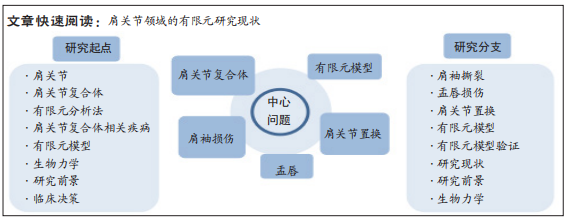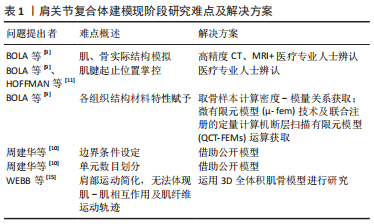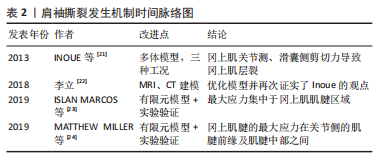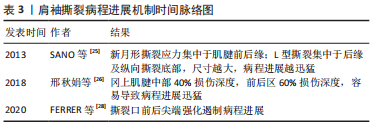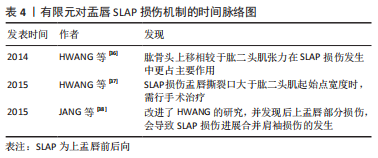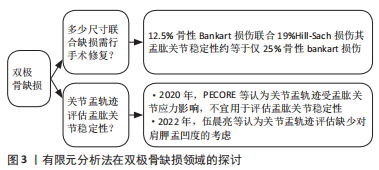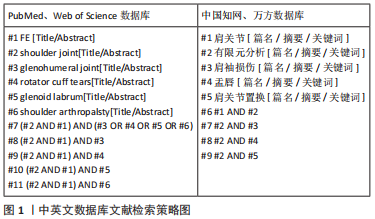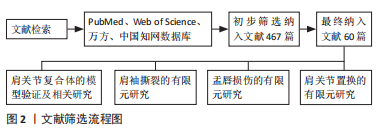[1] ABOUELKHAIR F, DUPREY S. Assessing shoulder posture ergonomy thanks to a finite element analysis. Comput Methods Biomech Biomed Engin. 2012; 15 Suppl 1:348-349.
[2] ZHENG M, ZOU Z, BARTOLO PJ, et al. Finite element models of the human shoulder complex: a review of their clinical implications and modelling techniques. Int J Numer Method Biomed Eng. 2017;33(2):e02777.
[3] BOLSTERLEE B, VEEGER DH, CHADWICK EK. Clinical applications of musculoskeletal modelling for the shoulder and upper limb. Med Biol Eng Comput. 2013;51(9):953-963.
[4] DAHAN G, TRABELSI N, SAFRAN O, et al. Finite element analyses for predicting anatomical neck fractures in the proximal humerus. Clin Biomech (Bristol, Avon). 2019;68:114-121.
[5] MENEGAZ GL, GOMIDE LC, ARAUJO CA. Biomechanical evaluation of acromioclavicular joint reconstructions using a 3-dimensional model based on the finite element method. Clin Biomech (Bristol, Avon). 2019;70:170-176.
[6] GAO R, ZHANG W, YANG Y, et al. Evaluation of the coracoid bone tunnel placement on Dog Bone button fixation for acromioclavicular joint dislocation: a cadaver study combined with finite element analysis. BMC Musculoskelet Disord. 2023;24(1):18.
[7] WANG C, MA XY, LU LT, et al. A finite element model of the shoulder: application to the changes of biomechanical environment induced by postoperative malrotation of humeral shaft fracture. BMC Musculoskelet Disord. 2022;23(1):525.
[8] ELWELL JA, ATHWAL GS, WILLING R. Development and validation of a muscle wrapping model applied to intact and reverse total shoulder arthroplasty shoulders. J Orthop Res. 2018;36(12):3308-3317.
[9] BOLA M, SIMOES J, RAMOS A. Finite element model validation based on an experimental model of the intact shoulder joint. Med Eng Phys. 2021;87:1-8.
[10] 周建华,王跃.有限元分析在骨科中的应用及研究进展[J].实用医院临床杂志,2018,15(1):205-208.
[11] HOFFMANN M, BEGON M, LAFON Y, et al. Influence of glenohumeral joint muscle insertion on moment arms using a finite element model. Comput Methods Biomech Biomed Engin. 2020;23(14):1117-1126.
[12] HIK F, ACKLAND DC. The moment arms of the muscles spanning the glenohumeral joint: a systematic review. J Anat. 2019;234(1):1-15.
[13] KNOWLES NK, LANGOHR GDG, FAIEGHI M, et al. A comparison of density-modulus relationships used in finite element modeling of the shoulder. Med Eng Phys. 2019;66:40-46.
[14] SADEQI S, BAUMANN AP, GOEL VK, et al. A Validated Open-Source Shoulder Finite Element Model and Investigation of the Effect of Analysis Precision. Ann Biomed Eng. 2023;51(1):24-33.
[15] WEBB JD, BLEMKER SS, DELP SL. 3D finite element models of shoulder muscles for computing lines of actions and moment arms. Comput Methods Biomech Biomed Enging. 2012;17(8):829-837.
[16] KANATLI U, GEMALMAZ HC, OZTURK BY, et al. The role of radiological subacromial distance measurements in the subacromial impingement syndrome. Eur J Orthop Surg Traumatol. 2013;23(3):317-322.
[17] 范宁,藏磊,袁硕,等.有限元分析在肩袖撕裂中的应用进展[J].中华创伤骨科杂志,2021,23(8):732-736.
[18] GARVING C, JAKOB S, BAUER I, et al. Impingement Syndrome of the Shoulder. Dtsch Arztebl Int. 2017;114(45):765-776.
[19] EL-AMIN S F, 3RD, MAFFULLI N, MAI MC, et al. Coracoid Impingement and Morphology Is Associated with Fatty Infiltration and Rotator Cuff Tears. J Clin Med. 2022;11(9):2661.
[20] VIEHOFER AF, GERBER C, FAVRE P, et al. A larger critical shoulder angle requires more rotator cuff activity to preserve joint stability. J Orthop Res. 2016;34(6):961-968.
[21] INOUE A, CHOSA E, GOTO K, et al. Nonlinear stress analysis of the supraspinatus tendon using three-dimensional finite element analysis. Knee Surg Sports Traumatol Arthrosc. 2013;21(5):1151-1157.
[22] 李立.肩关节复合体有限元建模及肱骨外展动作中肩袖生物力学分析[D].上海:上海交通大学,2018.
[23] ISLAN MARCOS M, LECHOSA URQUIJO E, BLAYA HARO F, et al. Behavior under Load of A Human Shoulder: Finite Element Simulation and Analysis. J Med Syst. 2019;43(5):132.
[24] MATTHEW MILLER R, THUNES J, MUSAHL V, et al. A Validated, Specimen-Specific Finite Element Model of the Supraspinatus Tendon Mechanical Environment. J Biomech Eng. 2019;141(11):111003.
[25] SANO H, HATTA T, YAMAMOTO N, et al. Stress distribution within rotator cuff tendons with a crescent-shaped and an L-shaped tear. Am J Sports Med. 2013;41(10):2262-2269.
[26] 邢秋娟,赵东峰,戴薇薇,等.冈上肌部分损伤对肌腱应力分布影响的有限元分析[J].实用骨科杂志,2018,24(6):519-522.
[27] MILLER RM, THUNES J, MAITI S, et al. Effects of Tendon Degeneration on Predictions of Supraspinatus Tear Propagation. Ann Biomed Eng. 2019;47(1): 154-161.
[28] FERRER GA, FORTUNATO RN, MUSAHL V, et al. Effect of localized tendon remodeling on supraspinatus tear propagation. J Biomech. 2020;108:109903.
[29] MANTOVANI M, PELLEGRINI A, GAROFALO P, et al. A 3D finite element model for geometrical and mechanical comparison of different supraspinatus repair techniques. J Shoulder Elbow Surg. 2016;25(4):557-563.
[30] 包呼日查,齐岩松,陶立元,等.肩袖损伤修补金属锚钉置入角度——有限元分析[J].中华肩肘外科电子杂志,2019,7(1):56-62.
[31] CHEVALIER Y. Numerical Methodology to Evaluate the Effects of Bone Density and Cement Augmentation on Fixation Stiffness of Bone-Anchoring Devices. J Biomech Eng. 2015;137(9). doi: 10.1115/1.4030943.
[32] SANO H, IMAGAWA K, YAMAMOTO N, et al. Predicting failures of suture anchors used for rotator cuff repair: a CT-based 3-dimensional finite element analysis. Biomed Mater Eng. 2015;25(4):371-380.
[33] SANO H, TOKUNAGA M, NOGUCHI M, et al. Comparison of fixation properties between coil-type and screw-type anchors for rotator cuff repair: A virtual pullout testing using 3-dimensional finite element method. J Orthop Sci. 2016;21(4):452-457.
[34] KLEMT C, NOLTE D, GRIGORIADIS G, et al. The contribution of the glenoid labrum to glenohumeral stability under physiological joint loading using finite element analysis. Comput Methods Biomech Biomed Engin. 2017;20(15):1613-1622.
[35] DRURY NJ, ELLIS BJ, WEISS JA, et al. The impact of glenoid labrum thickness and modulus on labrum and glenohumeral capsule function. J Biomech Eng. 2010;132(12):121003.
[36] HWANG E, CARPENTER JE, HUGHES RE, et al. Effects of biceps tension and superior humeral head translation on the glenoid labrum. J Orthop Res. 2014;32(11):1424-1429.
[37] HWANG E, HUGHES RE, PALMER ML, et al. Effects of biceps tension on the torn superior glenoid labrum. J Orthop Res. 2015;33(10):1545-1551.
[38] JANG SW, YOO YS, LEE HY, et al. Stress Distribution in Superior Labral Complex and Rotator Cuff During In Vivo Shoulder Motion: A Finite Element Analysis. Arthroscopy. 2015;31(11):2073-2081.
[39] NAKAGAWA S, IUCHI R, HANAI H, et al. The Development Process of Bipolar Bone Defects From Primary to Recurrent Instability in Shoulders With Traumatic Anterior Instability. Am J Sports Med. 2019;47(3):695-703.
[40] GOLIJANIN P, PEEBLES L, ARNER JW, et al. Advanced 3-Dimensional Characterization of Hill-Sachs Lesions in 100 Anterior Shoulder Instability Patients. Arthroscopy. 2021;37(11):3255-3261.
[41] WALIA P, MINIACI A, JONES MH, et al. Influence of Combined Hill-Sachs and Bony Bankart Defects on Range of Motion in Anterior Instability of the Shoulder in a Finite Element Model. Arthroscopy. 2015;31(11):2119-2127.
[42] YAMAMOTO N, ITOI E, ABE H, et al. Contact between the glenoid and the humeral head in abduction, external rotation, and horizontal extension: a new concept of glenoid track. J Shoulder Elbow Surg. 2007;16(5):649-656.
[43] PECORA JOR, NEVES JUNIOR AT, ROESLER CRM, et al. Glenoid track evaluation by a validated finite-element shoulder numerical model. Orthop Traumatol Surg Res. 2020;106(4):735-742.
[44] 伍晨亮,赵金忠.肩胛盂轨迹概念在肩关节前向不稳诊疗中的应用与挑战[J].国际骨科学杂志,2022,43:261-266.
[45] KLEMT C, TODERITA D, NOLTE D, et al. The critical size of a defect in the glenoid causing anterior instability of the shoulder after a Bankart repair, under physiological joint loading. Bone Joint J. 2019;101-B(1):68-74.
[46] INOUE K, SUENAGA N, OIZUMI N, et al. Glenoid bone resorption after Bankart repair: finite element analysis of postoperative stress distribution of the glenoid. J Shoulder Elbow Surg. 2021;30(1):188-193.
[47] SANO H, KOMATSUDA T, ABE H, et al. Intra-articular biomechanical environment following modified Bristow and Latarjet procedures in shoulders with large glenoid defects: relationship with postoperative complications. J Shoulder Elbow Surg. 2021;30(10):2260-2269.
[48] UNSAL SS, YILDIRIM T, KAYALAR M. Comparison of two coracoid process transfer techniques on stress shielding using three-dimensional finite-element model. J Orthop Surg Res. 2022;17(1):371.
[49] NEER CS 2ND, CRAIG EV, FUKUDA H. Cuff-tear arthropathy. J Bone Joint Surg Am. 1983;65(9):1232-1244.
[50] RUGG CM, COUGHLAN MJ, LANSDOWN DA. Reverse Total Shoulder Arthroplasty: Biomechanics and Indications. Curr Rev Musculoskelet Med. 2019;12(4):542-553.
[51] ERNSTBRUNNER L, ANDRONIC O, GRUBHOFER F, et al. Long-term results of reverse total shoulder arthroplasty for rotator cuff dysfunction: a systematic review of longitudinal outcomes. J Shoulder Elbow Surg. 2019;28(4):774-781.
[52] HARITINIAN E G, BELGAID V, LINO T, et al. Reverse versus anatomical shoulder arthroplasty in patients with intact rotator cuff. Int Orthop. 2020; 44(11):2395-2405.
[53] AIM F, MARION B, KERROUMI Y, et al. One- or two-stage exchange for periprosthetic shoulder infection: Systematic review and meta-analysis. Orthop Traumatol Surg Res. 2020;106(1):5-15.
[54] REEVES JM, ATHWAL GS, JOHNSON JA, et al. The Effect of Inhomogeneous Trabecular Stiffness Relationship Selection on Finite Element Outcomes for Shoulder Arthroplasty. J Biomech Eng. 2019;141(3). doi: 10.1115/1.4042172.
[55] REIMERINGER M, NUNO N, DESMARAIS-TREPANIER C, et al. The influence of uncemented femoral stem length and design on its primary stability: a finite element analysis. Comput Methods Biomech Biomed Engin. 2013; 16(11):1221-1231.
[56] SOLTANMOHAMMADI P, TAVAKOLI A, LANGOHR GDG, et al. Structural analysis of hollow versus solid-stemmed shoulder implants of proximal humeri with different bone qualities. J Orthop Res. 2022;40(3):674-684.
[57] ARENAS-MIQUELEZ A, MURPHY RJ, ROSA A, et al. Impact of humeral and glenoid component variations on range of motion in reverse geometry total shoulder arthroplasty: a standardized computer model study. J Shoulder Elbow Surg. 2021;30(4):763-771.
[58] BOLA M, SIMOES JA, RAMOS A. Finite element modelling and experimental validation of a total implanted shoulder joint. Comput Methods Programs Biomed. 2021;207:106158.
[59] 柳金浪,段志豪,周游.反式全肩关节置换的研究进展[J].中国矫形外科杂志,2021,29:2063-2066.
[60] ELWELL J, CHOI J, WILLING R. Quantifying the competing relationship between adduction range of motion and baseplate micromotion with lateralization of reverse total shoulder arthroplasty. J Biomech. 2017;52:24-30. |
